Corporate Strategy Analysis: Global Pharmaceutical Industry Report
VerifiedAdded on 2023/01/13
|12
|4423
|98
Report
AI Summary
This report provides a comprehensive analysis of the global pharmaceutical industry, focusing on the period of 2021. It begins with an overview of the industry's growth, driven by factors such as an aging population and increasing healthcare awareness. The PESTEL analysis examines the political, economic, social, technological, environmental, and legal factors affecting the industry. Key findings include the impact of strict regulations, economic trends in healthcare spending, social shifts like an aging population and rising obesity rates, technological advancements in biotechnology, environmental concerns related to drug production, and legal aspects concerning drug safety and intellectual property. The report also applies Porter's Five Forces model to assess competitive dynamics, including the availability of substitutes, bargaining power of suppliers and buyers, the threat of new entrants, and the intensity of competitive rivalry. The analysis highlights the competitive nature of the industry, the influence of suppliers, and the impact of generic drugs and patent protection. The report concludes by summarizing the key challenges and opportunities facing the pharmaceutical industry.
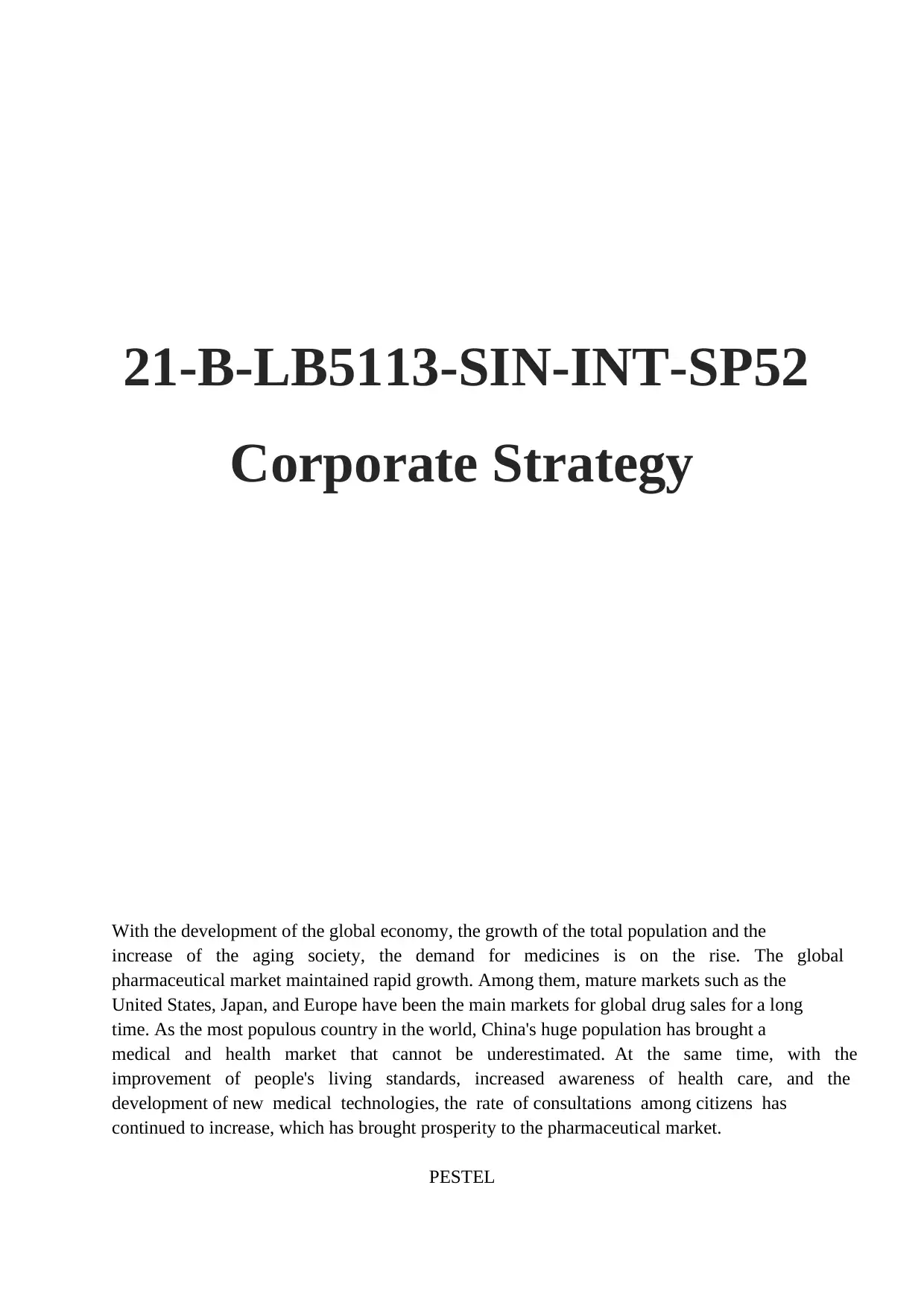
21-B-LB5113-SIN-INT-SP52
Corporate Strategy
With the development of the global economy, the growth of the total population and the
increase of the aging society, the demand for medicines is on the rise. The global
pharmaceutical market maintained rapid growth. Among them, mature markets such as the
United States, Japan, and Europe have been the main markets for global drug sales for a long
time. As the most populous country in the world, China's huge population has brought a
medical and health market that cannot be underestimated. At the same time, with the
improvement of people's living standards, increased awareness of health care, and the
development of new medical technologies, the rate of consultations among citizens has
continued to increase, which has brought prosperity to the pharmaceutical market.
PESTEL
Corporate Strategy
With the development of the global economy, the growth of the total population and the
increase of the aging society, the demand for medicines is on the rise. The global
pharmaceutical market maintained rapid growth. Among them, mature markets such as the
United States, Japan, and Europe have been the main markets for global drug sales for a long
time. As the most populous country in the world, China's huge population has brought a
medical and health market that cannot be underestimated. At the same time, with the
improvement of people's living standards, increased awareness of health care, and the
development of new medical technologies, the rate of consultations among citizens has
continued to increase, which has brought prosperity to the pharmaceutical market.
PESTEL
Paraphrase This Document
Need a fresh take? Get an instant paraphrase of this document with our AI Paraphraser
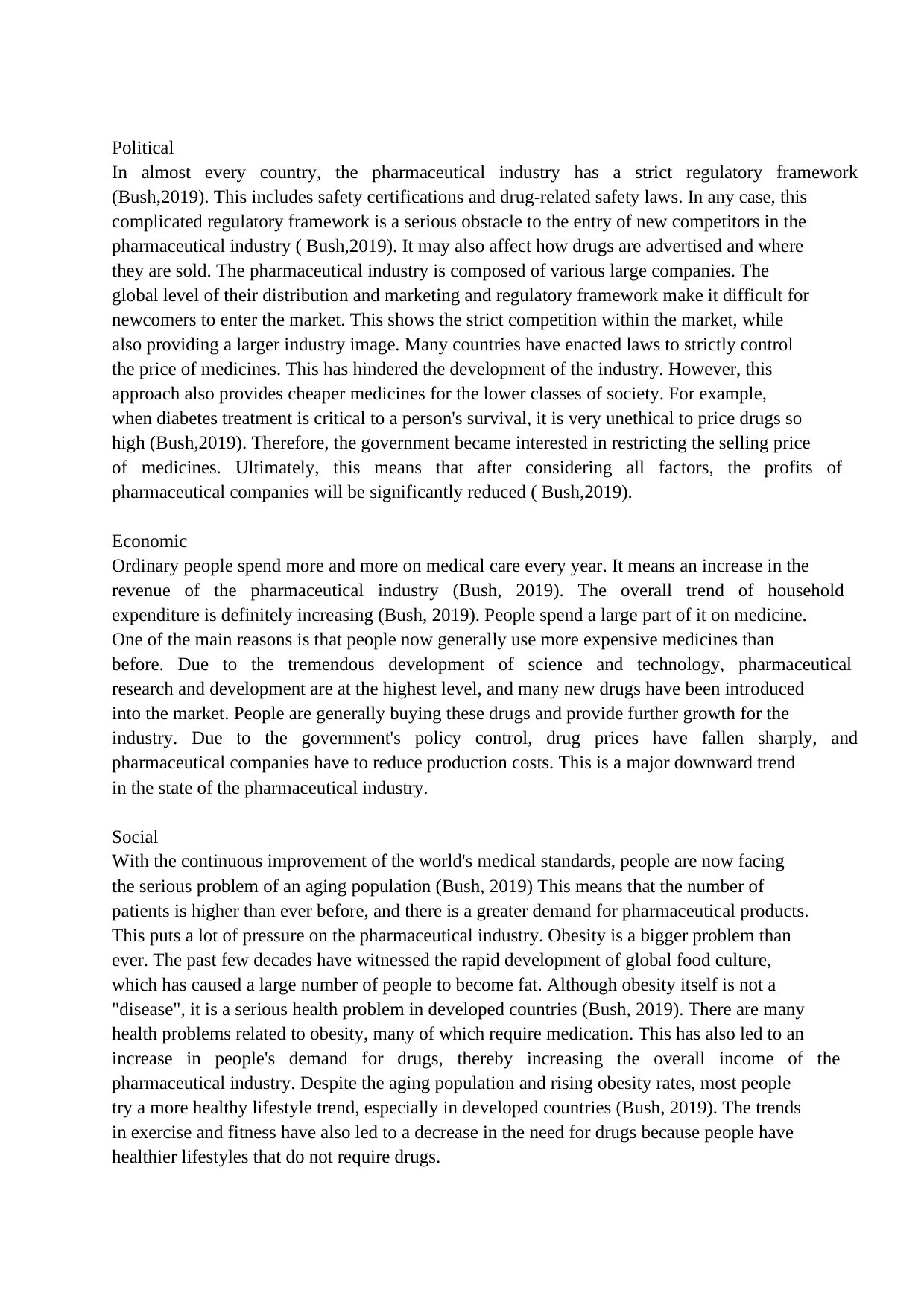
Political
In almost every country, the pharmaceutical industry has a strict regulatory framework
(Bush,2019). This includes safety certifications and drug-related safety laws. In any case, this
complicated regulatory framework is a serious obstacle to the entry of new competitors in the
pharmaceutical industry ( Bush,2019). It may also affect how drugs are advertised and where
they are sold. The pharmaceutical industry is composed of various large companies. The
global level of their distribution and marketing and regulatory framework make it difficult for
newcomers to enter the market. This shows the strict competition within the market, while
also providing a larger industry image. Many countries have enacted laws to strictly control
the price of medicines. This has hindered the development of the industry. However, this
approach also provides cheaper medicines for the lower classes of society. For example,
when diabetes treatment is critical to a person's survival, it is very unethical to price drugs so
high (Bush,2019). Therefore, the government became interested in restricting the selling price
of medicines. Ultimately, this means that after considering all factors, the profits of
pharmaceutical companies will be significantly reduced ( Bush,2019).
Economic
Ordinary people spend more and more on medical care every year. It means an increase in the
revenue of the pharmaceutical industry (Bush, 2019). The overall trend of household
expenditure is definitely increasing (Bush, 2019). People spend a large part of it on medicine.
One of the main reasons is that people now generally use more expensive medicines than
before. Due to the tremendous development of science and technology, pharmaceutical
research and development are at the highest level, and many new drugs have been introduced
into the market. People are generally buying these drugs and provide further growth for the
industry. Due to the government's policy control, drug prices have fallen sharply, and
pharmaceutical companies have to reduce production costs. This is a major downward trend
in the state of the pharmaceutical industry.
Social
With the continuous improvement of the world's medical standards, people are now facing
the serious problem of an aging population (Bush, 2019) This means that the number of
patients is higher than ever before, and there is a greater demand for pharmaceutical products.
This puts a lot of pressure on the pharmaceutical industry. Obesity is a bigger problem than
ever. The past few decades have witnessed the rapid development of global food culture,
which has caused a large number of people to become fat. Although obesity itself is not a
"disease", it is a serious health problem in developed countries (Bush, 2019). There are many
health problems related to obesity, many of which require medication. This has also led to an
increase in people's demand for drugs, thereby increasing the overall income of the
pharmaceutical industry. Despite the aging population and rising obesity rates, most people
try a more healthy lifestyle trend, especially in developed countries (Bush, 2019). The trends
in exercise and fitness have also led to a decrease in the need for drugs because people have
healthier lifestyles that do not require drugs.
In almost every country, the pharmaceutical industry has a strict regulatory framework
(Bush,2019). This includes safety certifications and drug-related safety laws. In any case, this
complicated regulatory framework is a serious obstacle to the entry of new competitors in the
pharmaceutical industry ( Bush,2019). It may also affect how drugs are advertised and where
they are sold. The pharmaceutical industry is composed of various large companies. The
global level of their distribution and marketing and regulatory framework make it difficult for
newcomers to enter the market. This shows the strict competition within the market, while
also providing a larger industry image. Many countries have enacted laws to strictly control
the price of medicines. This has hindered the development of the industry. However, this
approach also provides cheaper medicines for the lower classes of society. For example,
when diabetes treatment is critical to a person's survival, it is very unethical to price drugs so
high (Bush,2019). Therefore, the government became interested in restricting the selling price
of medicines. Ultimately, this means that after considering all factors, the profits of
pharmaceutical companies will be significantly reduced ( Bush,2019).
Economic
Ordinary people spend more and more on medical care every year. It means an increase in the
revenue of the pharmaceutical industry (Bush, 2019). The overall trend of household
expenditure is definitely increasing (Bush, 2019). People spend a large part of it on medicine.
One of the main reasons is that people now generally use more expensive medicines than
before. Due to the tremendous development of science and technology, pharmaceutical
research and development are at the highest level, and many new drugs have been introduced
into the market. People are generally buying these drugs and provide further growth for the
industry. Due to the government's policy control, drug prices have fallen sharply, and
pharmaceutical companies have to reduce production costs. This is a major downward trend
in the state of the pharmaceutical industry.
Social
With the continuous improvement of the world's medical standards, people are now facing
the serious problem of an aging population (Bush, 2019) This means that the number of
patients is higher than ever before, and there is a greater demand for pharmaceutical products.
This puts a lot of pressure on the pharmaceutical industry. Obesity is a bigger problem than
ever. The past few decades have witnessed the rapid development of global food culture,
which has caused a large number of people to become fat. Although obesity itself is not a
"disease", it is a serious health problem in developed countries (Bush, 2019). There are many
health problems related to obesity, many of which require medication. This has also led to an
increase in people's demand for drugs, thereby increasing the overall income of the
pharmaceutical industry. Despite the aging population and rising obesity rates, most people
try a more healthy lifestyle trend, especially in developed countries (Bush, 2019). The trends
in exercise and fitness have also led to a decrease in the need for drugs because people have
healthier lifestyles that do not require drugs.
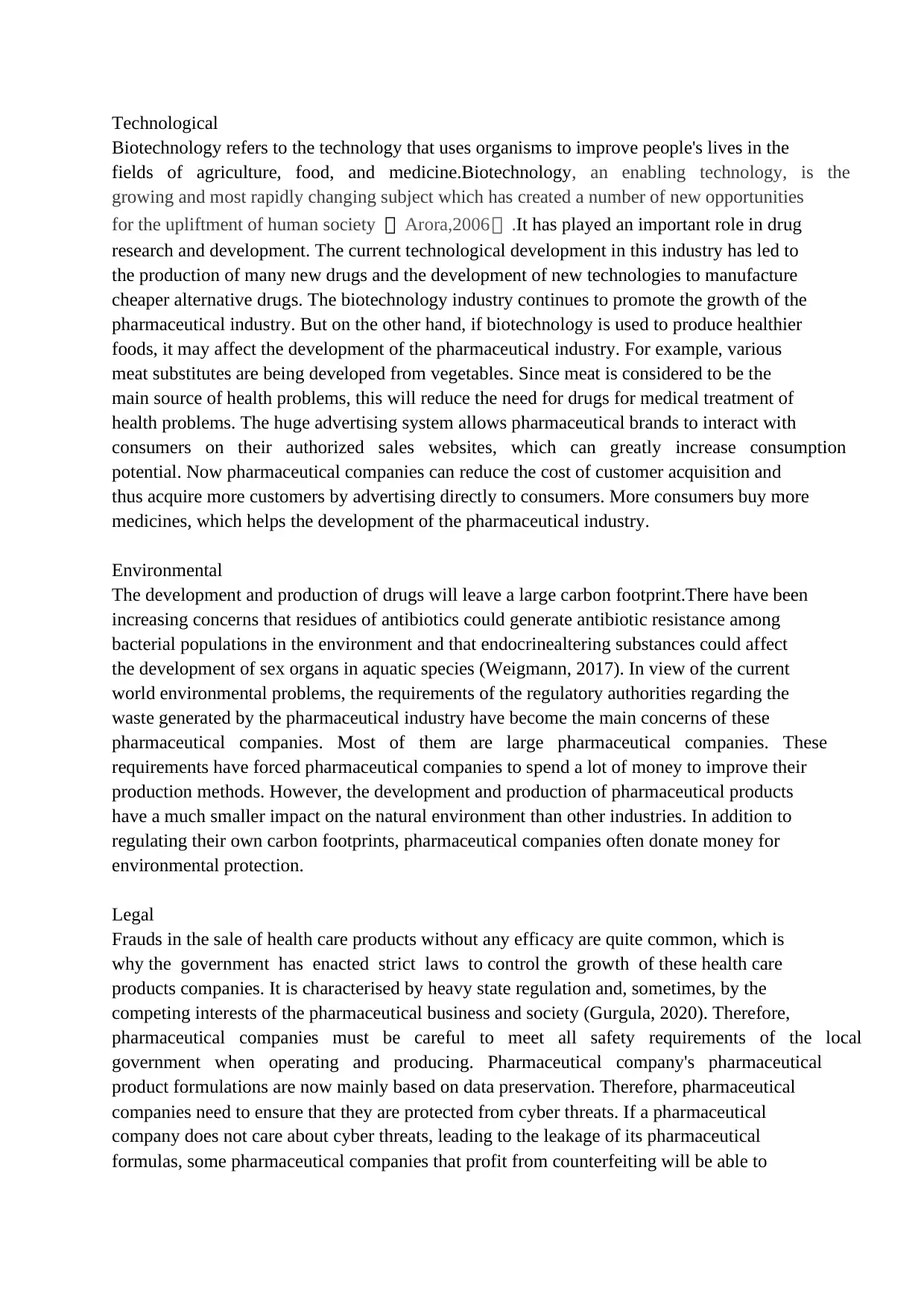
Technological
Biotechnology refers to the technology that uses organisms to improve people's lives in the
fields of agriculture, food, and medicine.Biotechnology, an enabling technology, is the
growing and most rapidly changing subject which has created a number of new opportunities
for the upliftment of human society ( Arora,2006( .It has played an important role in drug
research and development. The current technological development in this industry has led to
the production of many new drugs and the development of new technologies to manufacture
cheaper alternative drugs. The biotechnology industry continues to promote the growth of the
pharmaceutical industry. But on the other hand, if biotechnology is used to produce healthier
foods, it may affect the development of the pharmaceutical industry. For example, various
meat substitutes are being developed from vegetables. Since meat is considered to be the
main source of health problems, this will reduce the need for drugs for medical treatment of
health problems. The huge advertising system allows pharmaceutical brands to interact with
consumers on their authorized sales websites, which can greatly increase consumption
potential. Now pharmaceutical companies can reduce the cost of customer acquisition and
thus acquire more customers by advertising directly to consumers. More consumers buy more
medicines, which helps the development of the pharmaceutical industry.
Environmental
The development and production of drugs will leave a large carbon footprint.There have been
increasing concerns that residues of antibiotics could generate antibiotic resistance among
bacterial populations in the environment and that endocrinealtering substances could affect
the development of sex organs in aquatic species (Weigmann, 2017). In view of the current
world environmental problems, the requirements of the regulatory authorities regarding the
waste generated by the pharmaceutical industry have become the main concerns of these
pharmaceutical companies. Most of them are large pharmaceutical companies. These
requirements have forced pharmaceutical companies to spend a lot of money to improve their
production methods. However, the development and production of pharmaceutical products
have a much smaller impact on the natural environment than other industries. In addition to
regulating their own carbon footprints, pharmaceutical companies often donate money for
environmental protection.
Legal
Frauds in the sale of health care products without any efficacy are quite common, which is
why the government has enacted strict laws to control the growth of these health care
products companies. It is characterised by heavy state regulation and, sometimes, by the
competing interests of the pharmaceutical business and society (Gurgula, 2020). Therefore,
pharmaceutical companies must be careful to meet all safety requirements of the local
government when operating and producing. Pharmaceutical company's pharmaceutical
product formulations are now mainly based on data preservation. Therefore, pharmaceutical
companies need to ensure that they are protected from cyber threats. If a pharmaceutical
company does not care about cyber threats, leading to the leakage of its pharmaceutical
formulas, some pharmaceutical companies that profit from counterfeiting will be able to
Biotechnology refers to the technology that uses organisms to improve people's lives in the
fields of agriculture, food, and medicine.Biotechnology, an enabling technology, is the
growing and most rapidly changing subject which has created a number of new opportunities
for the upliftment of human society ( Arora,2006( .It has played an important role in drug
research and development. The current technological development in this industry has led to
the production of many new drugs and the development of new technologies to manufacture
cheaper alternative drugs. The biotechnology industry continues to promote the growth of the
pharmaceutical industry. But on the other hand, if biotechnology is used to produce healthier
foods, it may affect the development of the pharmaceutical industry. For example, various
meat substitutes are being developed from vegetables. Since meat is considered to be the
main source of health problems, this will reduce the need for drugs for medical treatment of
health problems. The huge advertising system allows pharmaceutical brands to interact with
consumers on their authorized sales websites, which can greatly increase consumption
potential. Now pharmaceutical companies can reduce the cost of customer acquisition and
thus acquire more customers by advertising directly to consumers. More consumers buy more
medicines, which helps the development of the pharmaceutical industry.
Environmental
The development and production of drugs will leave a large carbon footprint.There have been
increasing concerns that residues of antibiotics could generate antibiotic resistance among
bacterial populations in the environment and that endocrinealtering substances could affect
the development of sex organs in aquatic species (Weigmann, 2017). In view of the current
world environmental problems, the requirements of the regulatory authorities regarding the
waste generated by the pharmaceutical industry have become the main concerns of these
pharmaceutical companies. Most of them are large pharmaceutical companies. These
requirements have forced pharmaceutical companies to spend a lot of money to improve their
production methods. However, the development and production of pharmaceutical products
have a much smaller impact on the natural environment than other industries. In addition to
regulating their own carbon footprints, pharmaceutical companies often donate money for
environmental protection.
Legal
Frauds in the sale of health care products without any efficacy are quite common, which is
why the government has enacted strict laws to control the growth of these health care
products companies. It is characterised by heavy state regulation and, sometimes, by the
competing interests of the pharmaceutical business and society (Gurgula, 2020). Therefore,
pharmaceutical companies must be careful to meet all safety requirements of the local
government when operating and producing. Pharmaceutical company's pharmaceutical
product formulations are now mainly based on data preservation. Therefore, pharmaceutical
companies need to ensure that they are protected from cyber threats. If a pharmaceutical
company does not care about cyber threats, leading to the leakage of its pharmaceutical
formulas, some pharmaceutical companies that profit from counterfeiting will be able to
⊘ This is a preview!⊘
Do you want full access?
Subscribe today to unlock all pages.

Trusted by 1+ million students worldwide
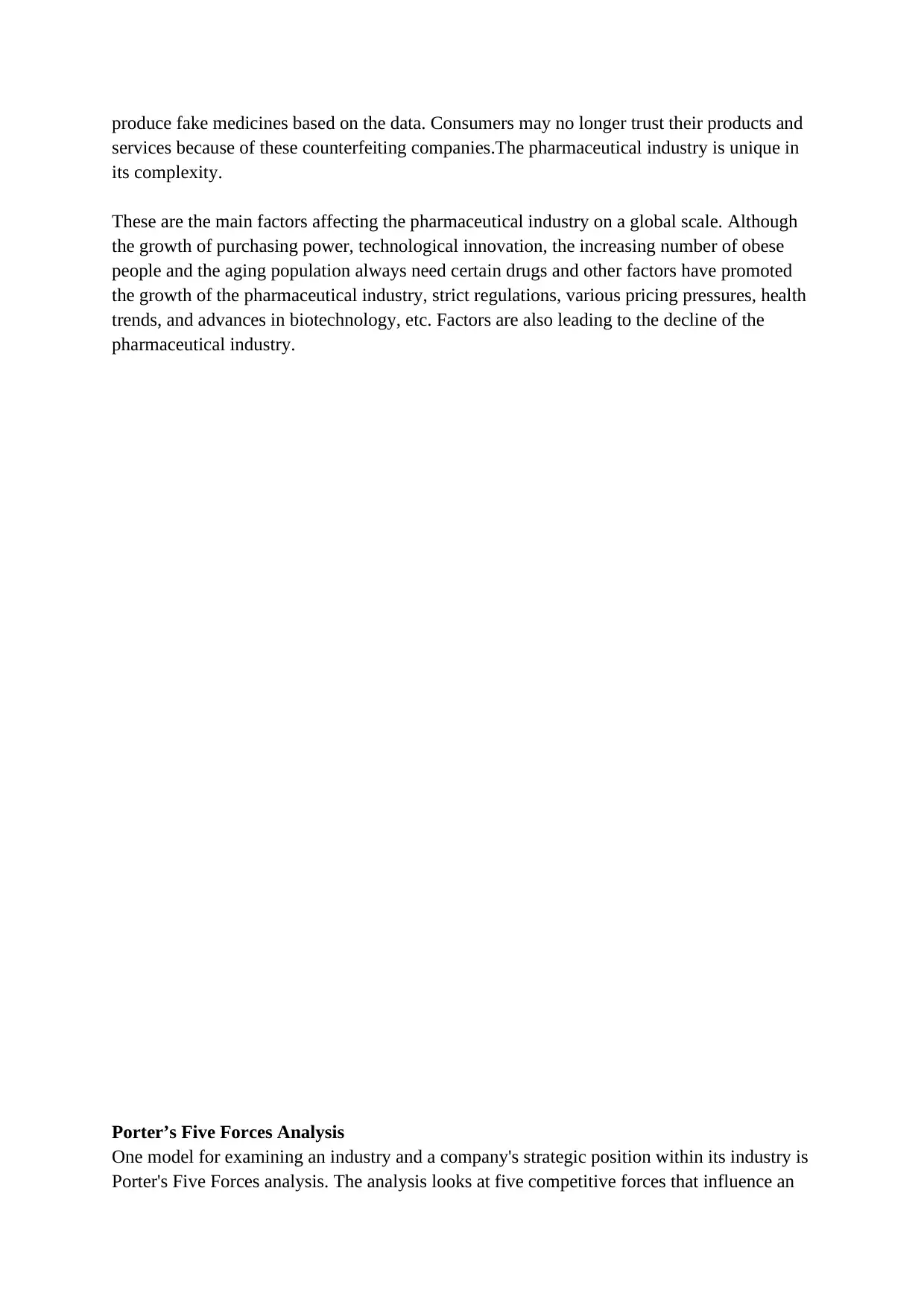
produce fake medicines based on the data. Consumers may no longer trust their products and
services because of these counterfeiting companies.The pharmaceutical industry is unique in
its complexity.
These are the main factors affecting the pharmaceutical industry on a global scale. Although
the growth of purchasing power, technological innovation, the increasing number of obese
people and the aging population always need certain drugs and other factors have promoted
the growth of the pharmaceutical industry, strict regulations, various pricing pressures, health
trends, and advances in biotechnology, etc. Factors are also leading to the decline of the
pharmaceutical industry.
Porter’s Five Forces Analysis
One model for examining an industry and a company's strategic position within its industry is
Porter's Five Forces analysis. The analysis looks at five competitive forces that influence an
services because of these counterfeiting companies.The pharmaceutical industry is unique in
its complexity.
These are the main factors affecting the pharmaceutical industry on a global scale. Although
the growth of purchasing power, technological innovation, the increasing number of obese
people and the aging population always need certain drugs and other factors have promoted
the growth of the pharmaceutical industry, strict regulations, various pricing pressures, health
trends, and advances in biotechnology, etc. Factors are also leading to the decline of the
pharmaceutical industry.
Porter’s Five Forces Analysis
One model for examining an industry and a company's strategic position within its industry is
Porter's Five Forces analysis. The analysis looks at five competitive forces that influence an
Paraphrase This Document
Need a fresh take? Get an instant paraphrase of this document with our AI Paraphraser
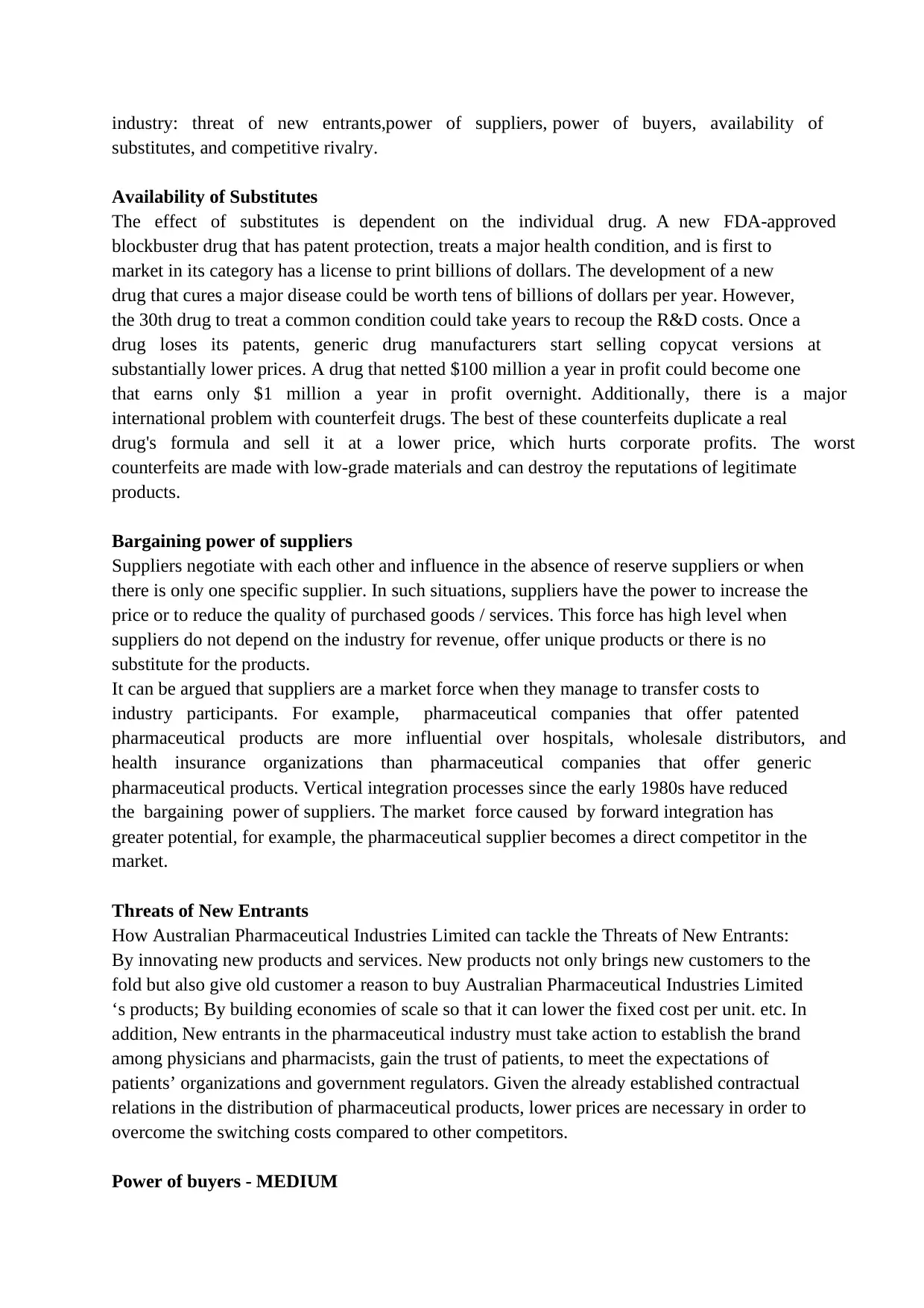
industry: threat of new entrants,power of suppliers, power of buyers, availability of
substitutes, and competitive rivalry.
Availability of Substitutes
The effect of substitutes is dependent on the individual drug. A new FDA-approved
blockbuster drug that has patent protection, treats a major health condition, and is first to
market in its category has a license to print billions of dollars. The development of a new
drug that cures a major disease could be worth tens of billions of dollars per year. However,
the 30th drug to treat a common condition could take years to recoup the R&D costs. Once a
drug loses its patents, generic drug manufacturers start selling copycat versions at
substantially lower prices. A drug that netted $100 million a year in profit could become one
that earns only $1 million a year in profit overnight. Additionally, there is a major
international problem with counterfeit drugs. The best of these counterfeits duplicate a real
drug's formula and sell it at a lower price, which hurts corporate profits. The worst
counterfeits are made with low-grade materials and can destroy the reputations of legitimate
products.
Bargaining power of suppliers
Suppliers negotiate with each other and influence in the absence of reserve suppliers or when
there is only one specific supplier. In such situations, suppliers have the power to increase the
price or to reduce the quality of purchased goods / services. This force has high level when
suppliers do not depend on the industry for revenue, offer unique products or there is no
substitute for the products.
It can be argued that suppliers are a market force when they manage to transfer costs to
industry participants. For example, pharmaceutical companies that offer patented
pharmaceutical products are more influential over hospitals, wholesale distributors, and
health insurance organizations than pharmaceutical companies that offer generic
pharmaceutical products. Vertical integration processes since the early 1980s have reduced
the bargaining power of suppliers. The market force caused by forward integration has
greater potential, for example, the pharmaceutical supplier becomes a direct competitor in the
market.
Threats of New Entrants
How Australian Pharmaceutical Industries Limited can tackle the Threats of New Entrants:
By innovating new products and services. New products not only brings new customers to the
fold but also give old customer a reason to buy Australian Pharmaceutical Industries Limited
‘s products; By building economies of scale so that it can lower the fixed cost per unit. etc. In
addition, New entrants in the pharmaceutical industry must take action to establish the brand
among physicians and pharmacists, gain the trust of patients, to meet the expectations of
patients’ organizations and government regulators. Given the already established contractual
relations in the distribution of pharmaceutical products, lower prices are necessary in order to
overcome the switching costs compared to other competitors.
Power of buyers - MEDIUM
substitutes, and competitive rivalry.
Availability of Substitutes
The effect of substitutes is dependent on the individual drug. A new FDA-approved
blockbuster drug that has patent protection, treats a major health condition, and is first to
market in its category has a license to print billions of dollars. The development of a new
drug that cures a major disease could be worth tens of billions of dollars per year. However,
the 30th drug to treat a common condition could take years to recoup the R&D costs. Once a
drug loses its patents, generic drug manufacturers start selling copycat versions at
substantially lower prices. A drug that netted $100 million a year in profit could become one
that earns only $1 million a year in profit overnight. Additionally, there is a major
international problem with counterfeit drugs. The best of these counterfeits duplicate a real
drug's formula and sell it at a lower price, which hurts corporate profits. The worst
counterfeits are made with low-grade materials and can destroy the reputations of legitimate
products.
Bargaining power of suppliers
Suppliers negotiate with each other and influence in the absence of reserve suppliers or when
there is only one specific supplier. In such situations, suppliers have the power to increase the
price or to reduce the quality of purchased goods / services. This force has high level when
suppliers do not depend on the industry for revenue, offer unique products or there is no
substitute for the products.
It can be argued that suppliers are a market force when they manage to transfer costs to
industry participants. For example, pharmaceutical companies that offer patented
pharmaceutical products are more influential over hospitals, wholesale distributors, and
health insurance organizations than pharmaceutical companies that offer generic
pharmaceutical products. Vertical integration processes since the early 1980s have reduced
the bargaining power of suppliers. The market force caused by forward integration has
greater potential, for example, the pharmaceutical supplier becomes a direct competitor in the
market.
Threats of New Entrants
How Australian Pharmaceutical Industries Limited can tackle the Threats of New Entrants:
By innovating new products and services. New products not only brings new customers to the
fold but also give old customer a reason to buy Australian Pharmaceutical Industries Limited
‘s products; By building economies of scale so that it can lower the fixed cost per unit. etc. In
addition, New entrants in the pharmaceutical industry must take action to establish the brand
among physicians and pharmacists, gain the trust of patients, to meet the expectations of
patients’ organizations and government regulators. Given the already established contractual
relations in the distribution of pharmaceutical products, lower prices are necessary in order to
overcome the switching costs compared to other competitors.
Power of buyers - MEDIUM
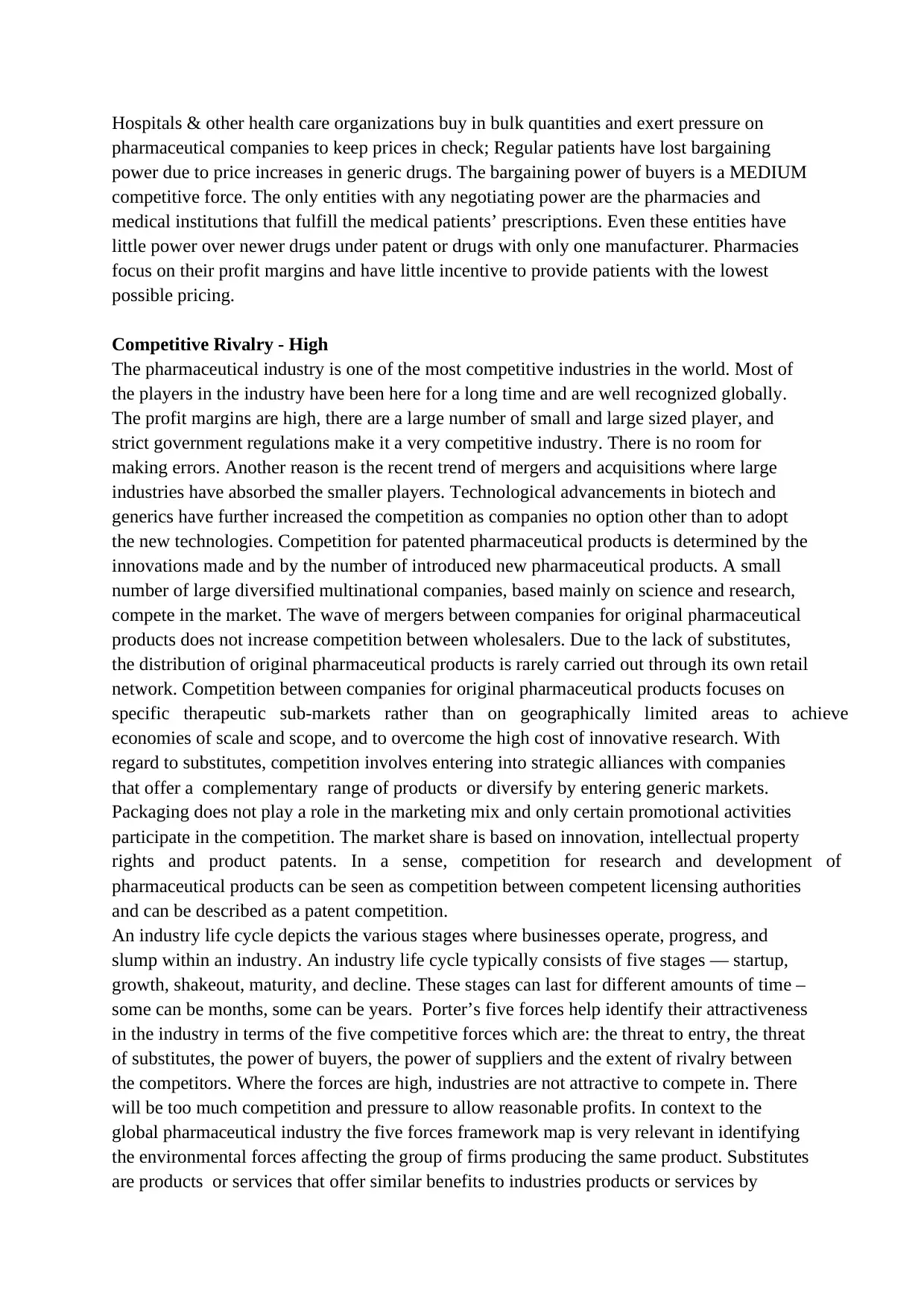
Hospitals & other health care organizations buy in bulk quantities and exert pressure on
pharmaceutical companies to keep prices in check; Regular patients have lost bargaining
power due to price increases in generic drugs. The bargaining power of buyers is a MEDIUM
competitive force. The only entities with any negotiating power are the pharmacies and
medical institutions that fulfill the medical patients’ prescriptions. Even these entities have
little power over newer drugs under patent or drugs with only one manufacturer. Pharmacies
focus on their profit margins and have little incentive to provide patients with the lowest
possible pricing.
Competitive Rivalry - High
The pharmaceutical industry is one of the most competitive industries in the world. Most of
the players in the industry have been here for a long time and are well recognized globally.
The profit margins are high, there are a large number of small and large sized player, and
strict government regulations make it a very competitive industry. There is no room for
making errors. Another reason is the recent trend of mergers and acquisitions where large
industries have absorbed the smaller players. Technological advancements in biotech and
generics have further increased the competition as companies no option other than to adopt
the new technologies. Competition for patented pharmaceutical products is determined by the
innovations made and by the number of introduced new pharmaceutical products. A small
number of large diversified multinational companies, based mainly on science and research,
compete in the market. The wave of mergers between companies for original pharmaceutical
products does not increase competition between wholesalers. Due to the lack of substitutes,
the distribution of original pharmaceutical products is rarely carried out through its own retail
network. Competition between companies for original pharmaceutical products focuses on
specific therapeutic sub-markets rather than on geographically limited areas to achieve
economies of scale and scope, and to overcome the high cost of innovative research. With
regard to substitutes, competition involves entering into strategic alliances with companies
that offer a complementary range of products or diversify by entering generic markets.
Packaging does not play a role in the marketing mix and only certain promotional activities
participate in the competition. The market share is based on innovation, intellectual property
rights and product patents. In a sense, competition for research and development of
pharmaceutical products can be seen as competition between competent licensing authorities
and can be described as a patent competition.
An industry life cycle depicts the various stages where businesses operate, progress, and
slump within an industry. An industry life cycle typically consists of five stages — startup,
growth, shakeout, maturity, and decline. These stages can last for different amounts of time –
some can be months, some can be years. Porter’s five forces help identify their attractiveness
in the industry in terms of the five competitive forces which are: the threat to entry, the threat
of substitutes, the power of buyers, the power of suppliers and the extent of rivalry between
the competitors. Where the forces are high, industries are not attractive to compete in. There
will be too much competition and pressure to allow reasonable profits. In context to the
global pharmaceutical industry the five forces framework map is very relevant in identifying
the environmental forces affecting the group of firms producing the same product. Substitutes
are products or services that offer similar benefits to industries products or services by
pharmaceutical companies to keep prices in check; Regular patients have lost bargaining
power due to price increases in generic drugs. The bargaining power of buyers is a MEDIUM
competitive force. The only entities with any negotiating power are the pharmacies and
medical institutions that fulfill the medical patients’ prescriptions. Even these entities have
little power over newer drugs under patent or drugs with only one manufacturer. Pharmacies
focus on their profit margins and have little incentive to provide patients with the lowest
possible pricing.
Competitive Rivalry - High
The pharmaceutical industry is one of the most competitive industries in the world. Most of
the players in the industry have been here for a long time and are well recognized globally.
The profit margins are high, there are a large number of small and large sized player, and
strict government regulations make it a very competitive industry. There is no room for
making errors. Another reason is the recent trend of mergers and acquisitions where large
industries have absorbed the smaller players. Technological advancements in biotech and
generics have further increased the competition as companies no option other than to adopt
the new technologies. Competition for patented pharmaceutical products is determined by the
innovations made and by the number of introduced new pharmaceutical products. A small
number of large diversified multinational companies, based mainly on science and research,
compete in the market. The wave of mergers between companies for original pharmaceutical
products does not increase competition between wholesalers. Due to the lack of substitutes,
the distribution of original pharmaceutical products is rarely carried out through its own retail
network. Competition between companies for original pharmaceutical products focuses on
specific therapeutic sub-markets rather than on geographically limited areas to achieve
economies of scale and scope, and to overcome the high cost of innovative research. With
regard to substitutes, competition involves entering into strategic alliances with companies
that offer a complementary range of products or diversify by entering generic markets.
Packaging does not play a role in the marketing mix and only certain promotional activities
participate in the competition. The market share is based on innovation, intellectual property
rights and product patents. In a sense, competition for research and development of
pharmaceutical products can be seen as competition between competent licensing authorities
and can be described as a patent competition.
An industry life cycle depicts the various stages where businesses operate, progress, and
slump within an industry. An industry life cycle typically consists of five stages — startup,
growth, shakeout, maturity, and decline. These stages can last for different amounts of time –
some can be months, some can be years. Porter’s five forces help identify their attractiveness
in the industry in terms of the five competitive forces which are: the threat to entry, the threat
of substitutes, the power of buyers, the power of suppliers and the extent of rivalry between
the competitors. Where the forces are high, industries are not attractive to compete in. There
will be too much competition and pressure to allow reasonable profits. In context to the
global pharmaceutical industry the five forces framework map is very relevant in identifying
the environmental forces affecting the group of firms producing the same product. Substitutes
are products or services that offer similar benefits to industries products or services by
⊘ This is a preview!⊘
Do you want full access?
Subscribe today to unlock all pages.

Trusted by 1+ million students worldwide
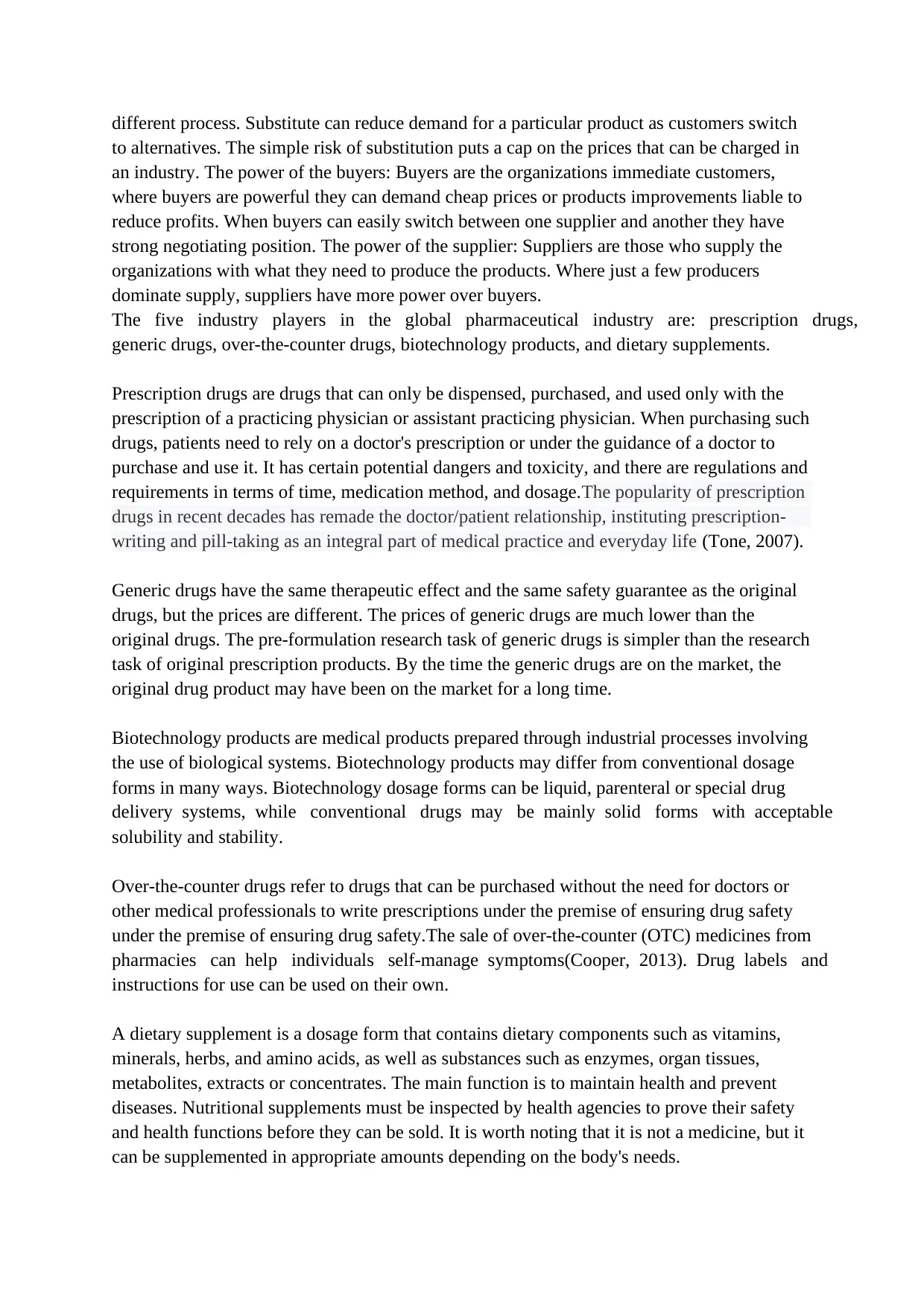
different process. Substitute can reduce demand for a particular product as customers switch
to alternatives. The simple risk of substitution puts a cap on the prices that can be charged in
an industry. The power of the buyers: Buyers are the organizations immediate customers,
where buyers are powerful they can demand cheap prices or products improvements liable to
reduce profits. When buyers can easily switch between one supplier and another they have
strong negotiating position. The power of the supplier: Suppliers are those who supply the
organizations with what they need to produce the products. Where just a few producers
dominate supply, suppliers have more power over buyers.
The five industry players in the global pharmaceutical industry are: prescription drugs,
generic drugs, over-the-counter drugs, biotechnology products, and dietary supplements.
Prescription drugs are drugs that can only be dispensed, purchased, and used only with the
prescription of a practicing physician or assistant practicing physician. When purchasing such
drugs, patients need to rely on a doctor's prescription or under the guidance of a doctor to
purchase and use it. It has certain potential dangers and toxicity, and there are regulations and
requirements in terms of time, medication method, and dosage.The popularity of prescription
drugs in recent decades has remade the doctor/patient relationship, instituting prescription-
writing and pill-taking as an integral part of medical practice and everyday life (Tone, 2007).
Generic drugs have the same therapeutic effect and the same safety guarantee as the original
drugs, but the prices are different. The prices of generic drugs are much lower than the
original drugs. The pre-formulation research task of generic drugs is simpler than the research
task of original prescription products. By the time the generic drugs are on the market, the
original drug product may have been on the market for a long time.
Biotechnology products are medical products prepared through industrial processes involving
the use of biological systems. Biotechnology products may differ from conventional dosage
forms in many ways. Biotechnology dosage forms can be liquid, parenteral or special drug
delivery systems, while conventional drugs may be mainly solid forms with acceptable
solubility and stability.
Over-the-counter drugs refer to drugs that can be purchased without the need for doctors or
other medical professionals to write prescriptions under the premise of ensuring drug safety
under the premise of ensuring drug safety.The sale of over-the-counter (OTC) medicines from
pharmacies can help individuals self-manage symptoms(Cooper, 2013). Drug labels and
instructions for use can be used on their own.
A dietary supplement is a dosage form that contains dietary components such as vitamins,
minerals, herbs, and amino acids, as well as substances such as enzymes, organ tissues,
metabolites, extracts or concentrates. The main function is to maintain health and prevent
diseases. Nutritional supplements must be inspected by health agencies to prove their safety
and health functions before they can be sold. It is worth noting that it is not a medicine, but it
can be supplemented in appropriate amounts depending on the body's needs.
to alternatives. The simple risk of substitution puts a cap on the prices that can be charged in
an industry. The power of the buyers: Buyers are the organizations immediate customers,
where buyers are powerful they can demand cheap prices or products improvements liable to
reduce profits. When buyers can easily switch between one supplier and another they have
strong negotiating position. The power of the supplier: Suppliers are those who supply the
organizations with what they need to produce the products. Where just a few producers
dominate supply, suppliers have more power over buyers.
The five industry players in the global pharmaceutical industry are: prescription drugs,
generic drugs, over-the-counter drugs, biotechnology products, and dietary supplements.
Prescription drugs are drugs that can only be dispensed, purchased, and used only with the
prescription of a practicing physician or assistant practicing physician. When purchasing such
drugs, patients need to rely on a doctor's prescription or under the guidance of a doctor to
purchase and use it. It has certain potential dangers and toxicity, and there are regulations and
requirements in terms of time, medication method, and dosage.The popularity of prescription
drugs in recent decades has remade the doctor/patient relationship, instituting prescription-
writing and pill-taking as an integral part of medical practice and everyday life (Tone, 2007).
Generic drugs have the same therapeutic effect and the same safety guarantee as the original
drugs, but the prices are different. The prices of generic drugs are much lower than the
original drugs. The pre-formulation research task of generic drugs is simpler than the research
task of original prescription products. By the time the generic drugs are on the market, the
original drug product may have been on the market for a long time.
Biotechnology products are medical products prepared through industrial processes involving
the use of biological systems. Biotechnology products may differ from conventional dosage
forms in many ways. Biotechnology dosage forms can be liquid, parenteral or special drug
delivery systems, while conventional drugs may be mainly solid forms with acceptable
solubility and stability.
Over-the-counter drugs refer to drugs that can be purchased without the need for doctors or
other medical professionals to write prescriptions under the premise of ensuring drug safety
under the premise of ensuring drug safety.The sale of over-the-counter (OTC) medicines from
pharmacies can help individuals self-manage symptoms(Cooper, 2013). Drug labels and
instructions for use can be used on their own.
A dietary supplement is a dosage form that contains dietary components such as vitamins,
minerals, herbs, and amino acids, as well as substances such as enzymes, organ tissues,
metabolites, extracts or concentrates. The main function is to maintain health and prevent
diseases. Nutritional supplements must be inspected by health agencies to prove their safety
and health functions before they can be sold. It is worth noting that it is not a medicine, but it
can be supplemented in appropriate amounts depending on the body's needs.
Paraphrase This Document
Need a fresh take? Get an instant paraphrase of this document with our AI Paraphraser
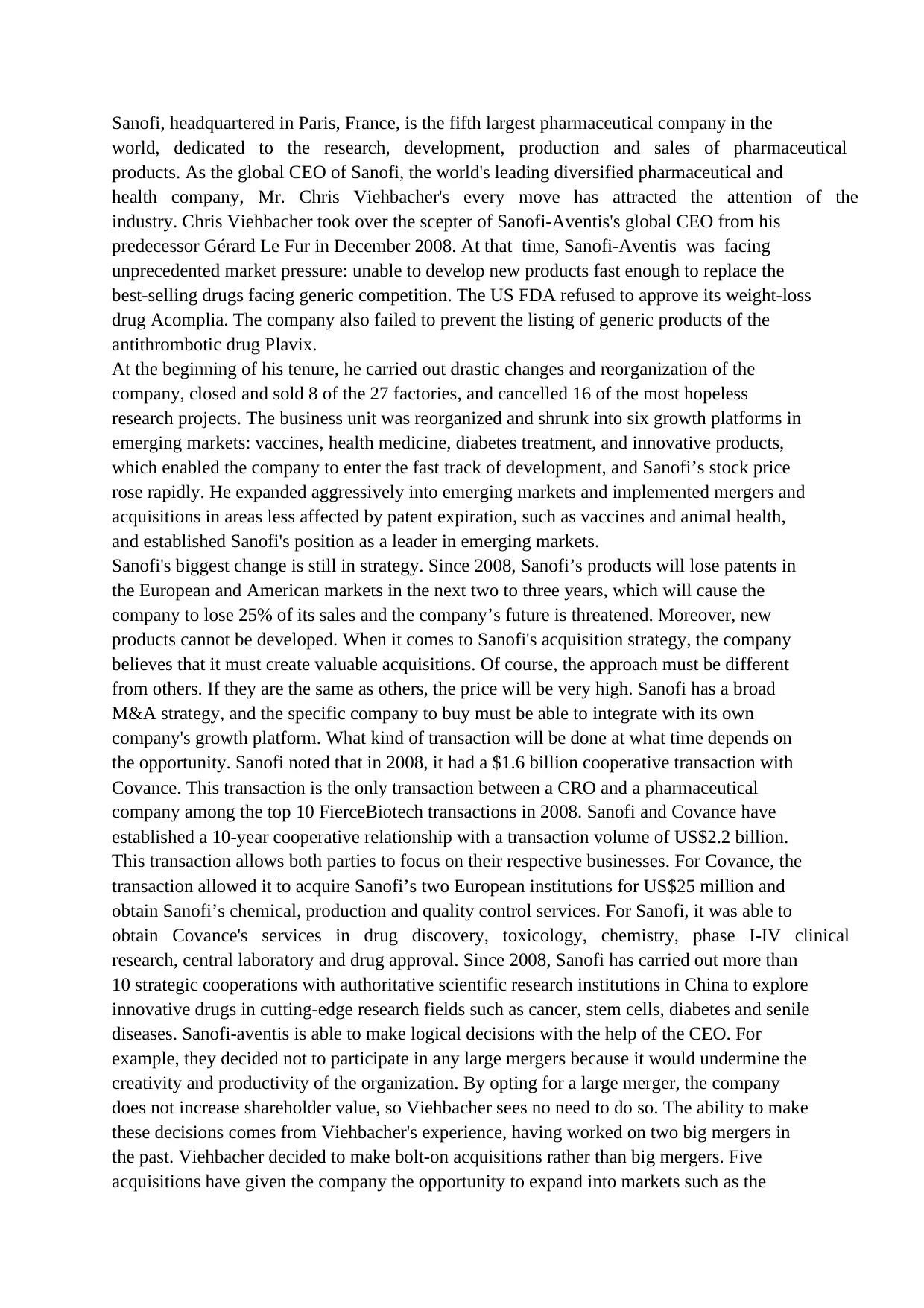
Sanofi, headquartered in Paris, France, is the fifth largest pharmaceutical company in the
world, dedicated to the research, development, production and sales of pharmaceutical
products. As the global CEO of Sanofi, the world's leading diversified pharmaceutical and
health company, Mr. Chris Viehbacher's every move has attracted the attention of the
industry. Chris Viehbacher took over the scepter of Sanofi-Aventis's global CEO from his
predecessor Gérard Le Fur in December 2008. At that time, Sanofi-Aventis was facing
unprecedented market pressure: unable to develop new products fast enough to replace the
best-selling drugs facing generic competition. The US FDA refused to approve its weight-loss
drug Acomplia. The company also failed to prevent the listing of generic products of the
antithrombotic drug Plavix.
At the beginning of his tenure, he carried out drastic changes and reorganization of the
company, closed and sold 8 of the 27 factories, and cancelled 16 of the most hopeless
research projects. The business unit was reorganized and shrunk into six growth platforms in
emerging markets: vaccines, health medicine, diabetes treatment, and innovative products,
which enabled the company to enter the fast track of development, and Sanofi’s stock price
rose rapidly. He expanded aggressively into emerging markets and implemented mergers and
acquisitions in areas less affected by patent expiration, such as vaccines and animal health,
and established Sanofi's position as a leader in emerging markets.
Sanofi's biggest change is still in strategy. Since 2008, Sanofi’s products will lose patents in
the European and American markets in the next two to three years, which will cause the
company to lose 25% of its sales and the company’s future is threatened. Moreover, new
products cannot be developed. When it comes to Sanofi's acquisition strategy, the company
believes that it must create valuable acquisitions. Of course, the approach must be different
from others. If they are the same as others, the price will be very high. Sanofi has a broad
M&A strategy, and the specific company to buy must be able to integrate with its own
company's growth platform. What kind of transaction will be done at what time depends on
the opportunity. Sanofi noted that in 2008, it had a $1.6 billion cooperative transaction with
Covance. This transaction is the only transaction between a CRO and a pharmaceutical
company among the top 10 FierceBiotech transactions in 2008. Sanofi and Covance have
established a 10-year cooperative relationship with a transaction volume of US$2.2 billion.
This transaction allows both parties to focus on their respective businesses. For Covance, the
transaction allowed it to acquire Sanofi’s two European institutions for US$25 million and
obtain Sanofi’s chemical, production and quality control services. For Sanofi, it was able to
obtain Covance's services in drug discovery, toxicology, chemistry, phase I-IV clinical
research, central laboratory and drug approval. Since 2008, Sanofi has carried out more than
10 strategic cooperations with authoritative scientific research institutions in China to explore
innovative drugs in cutting-edge research fields such as cancer, stem cells, diabetes and senile
diseases. Sanofi-aventis is able to make logical decisions with the help of the CEO. For
example, they decided not to participate in any large mergers because it would undermine the
creativity and productivity of the organization. By opting for a large merger, the company
does not increase shareholder value, so Viehbacher sees no need to do so. The ability to make
these decisions comes from Viehbacher's experience, having worked on two big mergers in
the past. Viehbacher decided to make bolt-on acquisitions rather than big mergers. Five
acquisitions have given the company the opportunity to expand into markets such as the
world, dedicated to the research, development, production and sales of pharmaceutical
products. As the global CEO of Sanofi, the world's leading diversified pharmaceutical and
health company, Mr. Chris Viehbacher's every move has attracted the attention of the
industry. Chris Viehbacher took over the scepter of Sanofi-Aventis's global CEO from his
predecessor Gérard Le Fur in December 2008. At that time, Sanofi-Aventis was facing
unprecedented market pressure: unable to develop new products fast enough to replace the
best-selling drugs facing generic competition. The US FDA refused to approve its weight-loss
drug Acomplia. The company also failed to prevent the listing of generic products of the
antithrombotic drug Plavix.
At the beginning of his tenure, he carried out drastic changes and reorganization of the
company, closed and sold 8 of the 27 factories, and cancelled 16 of the most hopeless
research projects. The business unit was reorganized and shrunk into six growth platforms in
emerging markets: vaccines, health medicine, diabetes treatment, and innovative products,
which enabled the company to enter the fast track of development, and Sanofi’s stock price
rose rapidly. He expanded aggressively into emerging markets and implemented mergers and
acquisitions in areas less affected by patent expiration, such as vaccines and animal health,
and established Sanofi's position as a leader in emerging markets.
Sanofi's biggest change is still in strategy. Since 2008, Sanofi’s products will lose patents in
the European and American markets in the next two to three years, which will cause the
company to lose 25% of its sales and the company’s future is threatened. Moreover, new
products cannot be developed. When it comes to Sanofi's acquisition strategy, the company
believes that it must create valuable acquisitions. Of course, the approach must be different
from others. If they are the same as others, the price will be very high. Sanofi has a broad
M&A strategy, and the specific company to buy must be able to integrate with its own
company's growth platform. What kind of transaction will be done at what time depends on
the opportunity. Sanofi noted that in 2008, it had a $1.6 billion cooperative transaction with
Covance. This transaction is the only transaction between a CRO and a pharmaceutical
company among the top 10 FierceBiotech transactions in 2008. Sanofi and Covance have
established a 10-year cooperative relationship with a transaction volume of US$2.2 billion.
This transaction allows both parties to focus on their respective businesses. For Covance, the
transaction allowed it to acquire Sanofi’s two European institutions for US$25 million and
obtain Sanofi’s chemical, production and quality control services. For Sanofi, it was able to
obtain Covance's services in drug discovery, toxicology, chemistry, phase I-IV clinical
research, central laboratory and drug approval. Since 2008, Sanofi has carried out more than
10 strategic cooperations with authoritative scientific research institutions in China to explore
innovative drugs in cutting-edge research fields such as cancer, stem cells, diabetes and senile
diseases. Sanofi-aventis is able to make logical decisions with the help of the CEO. For
example, they decided not to participate in any large mergers because it would undermine the
creativity and productivity of the organization. By opting for a large merger, the company
does not increase shareholder value, so Viehbacher sees no need to do so. The ability to make
these decisions comes from Viehbacher's experience, having worked on two big mergers in
the past. Viehbacher decided to make bolt-on acquisitions rather than big mergers. Five
acquisitions have given the company the opportunity to expand into markets such as the
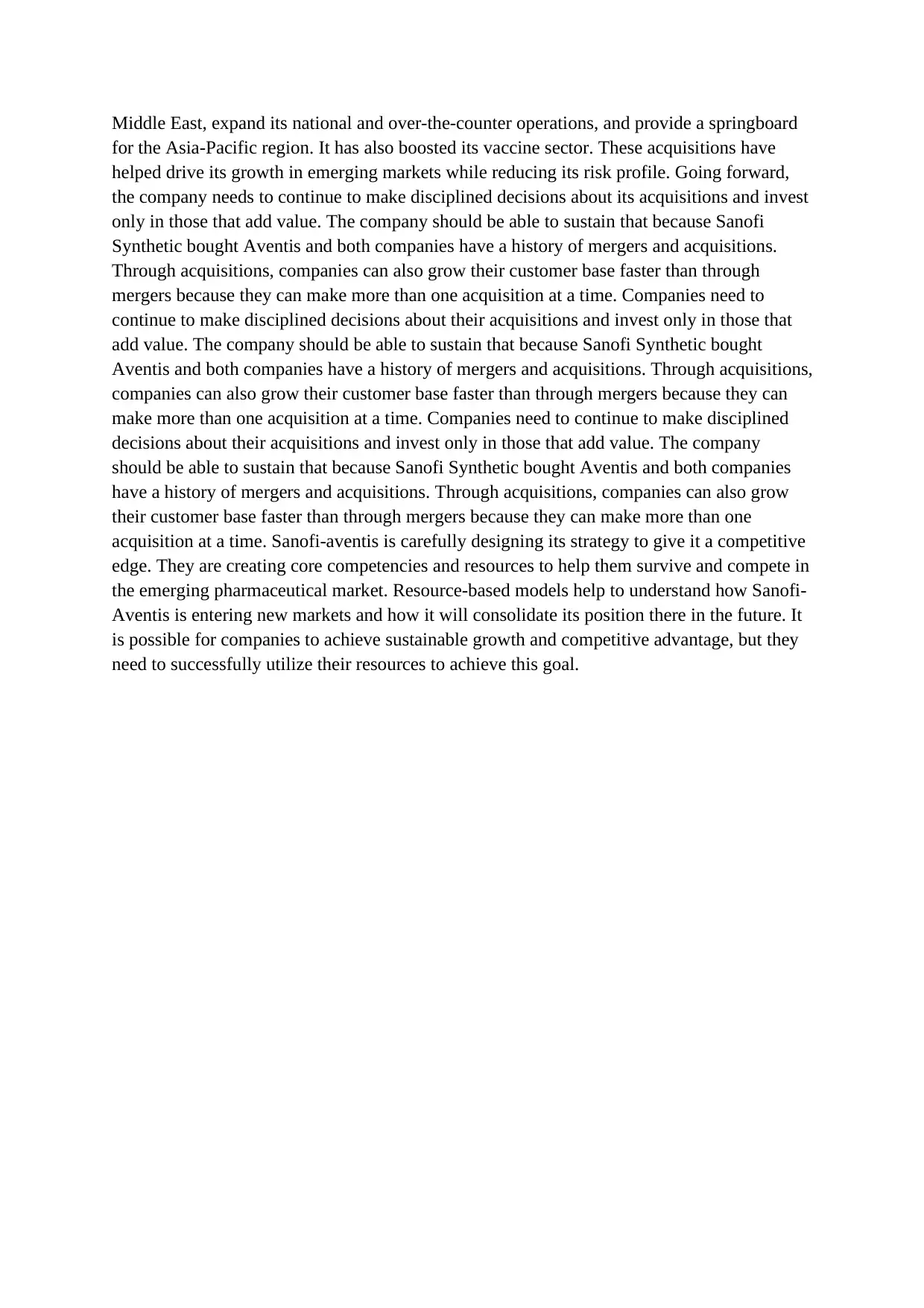
Middle East, expand its national and over-the-counter operations, and provide a springboard
for the Asia-Pacific region. It has also boosted its vaccine sector. These acquisitions have
helped drive its growth in emerging markets while reducing its risk profile. Going forward,
the company needs to continue to make disciplined decisions about its acquisitions and invest
only in those that add value. The company should be able to sustain that because Sanofi
Synthetic bought Aventis and both companies have a history of mergers and acquisitions.
Through acquisitions, companies can also grow their customer base faster than through
mergers because they can make more than one acquisition at a time. Companies need to
continue to make disciplined decisions about their acquisitions and invest only in those that
add value. The company should be able to sustain that because Sanofi Synthetic bought
Aventis and both companies have a history of mergers and acquisitions. Through acquisitions,
companies can also grow their customer base faster than through mergers because they can
make more than one acquisition at a time. Companies need to continue to make disciplined
decisions about their acquisitions and invest only in those that add value. The company
should be able to sustain that because Sanofi Synthetic bought Aventis and both companies
have a history of mergers and acquisitions. Through acquisitions, companies can also grow
their customer base faster than through mergers because they can make more than one
acquisition at a time. Sanofi-aventis is carefully designing its strategy to give it a competitive
edge. They are creating core competencies and resources to help them survive and compete in
the emerging pharmaceutical market. Resource-based models help to understand how Sanofi-
Aventis is entering new markets and how it will consolidate its position there in the future. It
is possible for companies to achieve sustainable growth and competitive advantage, but they
need to successfully utilize their resources to achieve this goal.
for the Asia-Pacific region. It has also boosted its vaccine sector. These acquisitions have
helped drive its growth in emerging markets while reducing its risk profile. Going forward,
the company needs to continue to make disciplined decisions about its acquisitions and invest
only in those that add value. The company should be able to sustain that because Sanofi
Synthetic bought Aventis and both companies have a history of mergers and acquisitions.
Through acquisitions, companies can also grow their customer base faster than through
mergers because they can make more than one acquisition at a time. Companies need to
continue to make disciplined decisions about their acquisitions and invest only in those that
add value. The company should be able to sustain that because Sanofi Synthetic bought
Aventis and both companies have a history of mergers and acquisitions. Through acquisitions,
companies can also grow their customer base faster than through mergers because they can
make more than one acquisition at a time. Companies need to continue to make disciplined
decisions about their acquisitions and invest only in those that add value. The company
should be able to sustain that because Sanofi Synthetic bought Aventis and both companies
have a history of mergers and acquisitions. Through acquisitions, companies can also grow
their customer base faster than through mergers because they can make more than one
acquisition at a time. Sanofi-aventis is carefully designing its strategy to give it a competitive
edge. They are creating core competencies and resources to help them survive and compete in
the emerging pharmaceutical market. Resource-based models help to understand how Sanofi-
Aventis is entering new markets and how it will consolidate its position there in the future. It
is possible for companies to achieve sustainable growth and competitive advantage, but they
need to successfully utilize their resources to achieve this goal.
⊘ This is a preview!⊘
Do you want full access?
Subscribe today to unlock all pages.

Trusted by 1+ million students worldwide
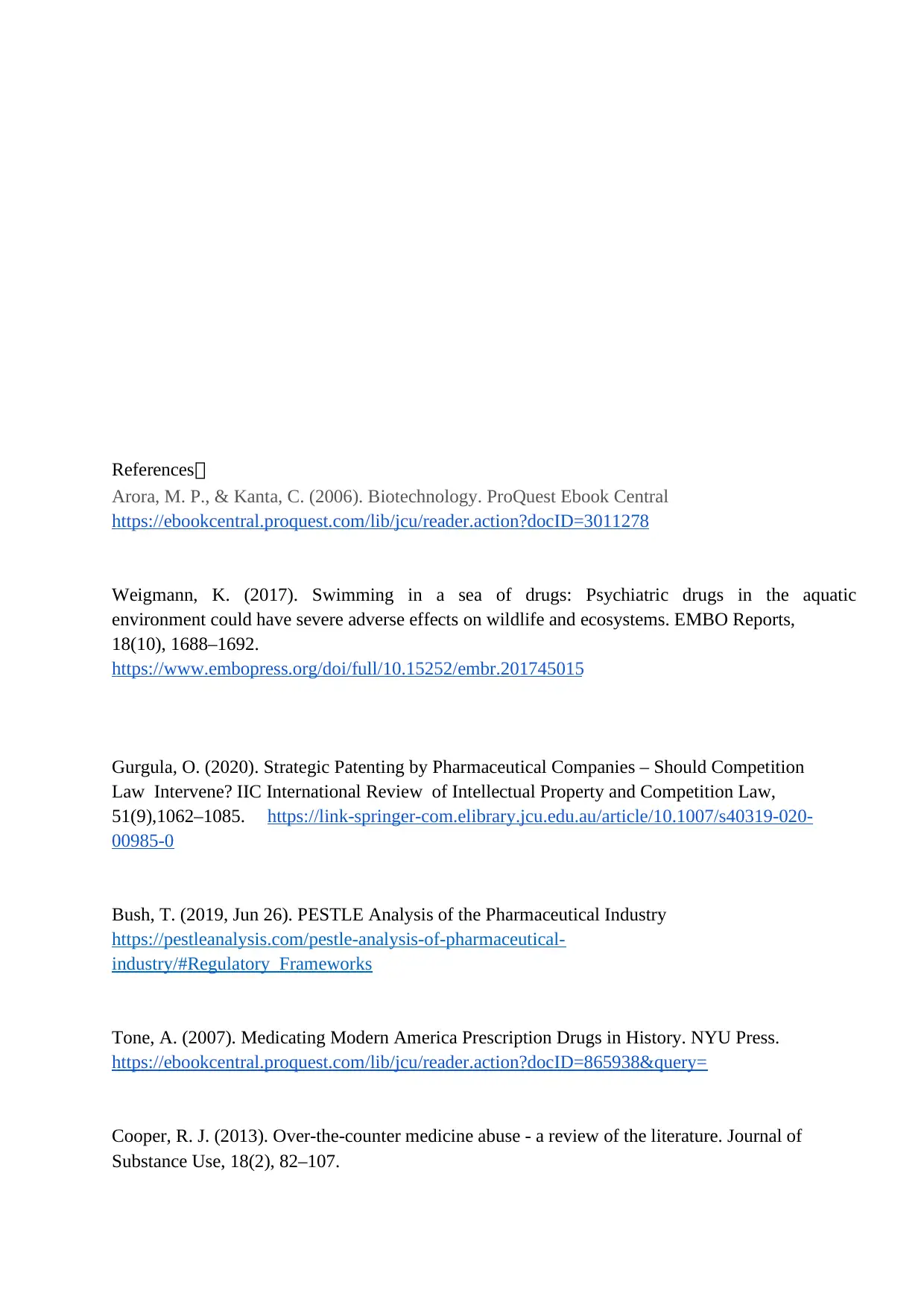
References(
Arora, M. P., & Kanta, C. (2006). Biotechnology. ProQuest Ebook Central
https://ebookcentral.proquest.com/lib/jcu/reader.action?docID=3011278
Weigmann, K. (2017). Swimming in a sea of drugs: Psychiatric drugs in the aquatic
environment could have severe adverse effects on wildlife and ecosystems. EMBO Reports,
18(10), 1688–1692.
https://www.embopress.org/doi/full/10.15252/embr.201745015
Gurgula, O. (2020). Strategic Patenting by Pharmaceutical Companies – Should Competition
Law Intervene? IIC International Review of Intellectual Property and Competition Law,
51(9),1062–1085. https://link-springer-com.elibrary.jcu.edu.au/article/10.1007/s40319-020-
00985-0
Bush, T. (2019, Jun 26). PESTLE Analysis of the Pharmaceutical Industry
https://pestleanalysis.com/pestle-analysis-of-pharmaceutical-
industry/#Regulatory_Frameworks
Tone, A. (2007). Medicating Modern America Prescription Drugs in History. NYU Press.
https://ebookcentral.proquest.com/lib/jcu/reader.action?docID=865938&query=
Cooper, R. J. (2013). Over-the-counter medicine abuse - a review of the literature. Journal of
Substance Use, 18(2), 82–107.
Arora, M. P., & Kanta, C. (2006). Biotechnology. ProQuest Ebook Central
https://ebookcentral.proquest.com/lib/jcu/reader.action?docID=3011278
Weigmann, K. (2017). Swimming in a sea of drugs: Psychiatric drugs in the aquatic
environment could have severe adverse effects on wildlife and ecosystems. EMBO Reports,
18(10), 1688–1692.
https://www.embopress.org/doi/full/10.15252/embr.201745015
Gurgula, O. (2020). Strategic Patenting by Pharmaceutical Companies – Should Competition
Law Intervene? IIC International Review of Intellectual Property and Competition Law,
51(9),1062–1085. https://link-springer-com.elibrary.jcu.edu.au/article/10.1007/s40319-020-
00985-0
Bush, T. (2019, Jun 26). PESTLE Analysis of the Pharmaceutical Industry
https://pestleanalysis.com/pestle-analysis-of-pharmaceutical-
industry/#Regulatory_Frameworks
Tone, A. (2007). Medicating Modern America Prescription Drugs in History. NYU Press.
https://ebookcentral.proquest.com/lib/jcu/reader.action?docID=865938&query=
Cooper, R. J. (2013). Over-the-counter medicine abuse - a review of the literature. Journal of
Substance Use, 18(2), 82–107.
Paraphrase This Document
Need a fresh take? Get an instant paraphrase of this document with our AI Paraphraser
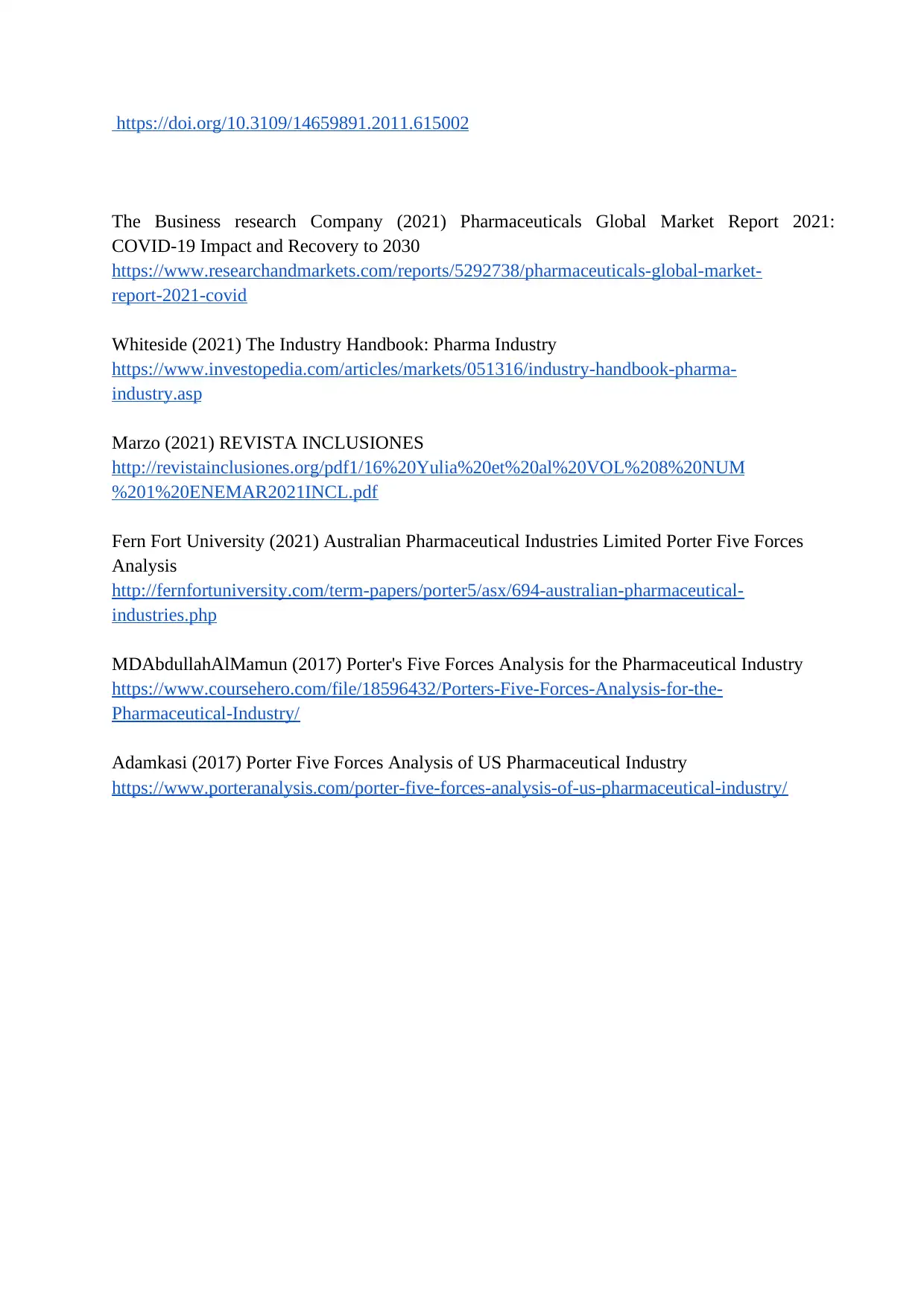
https://doi.org/10.3109/14659891.2011.615002
The Business research Company (2021) Pharmaceuticals Global Market Report 2021:
COVID-19 Impact and Recovery to 2030
https://www.researchandmarkets.com/reports/5292738/pharmaceuticals-global-market-
report-2021-covid
Whiteside (2021) The Industry Handbook: Pharma Industry
https://www.investopedia.com/articles/markets/051316/industry-handbook-pharma-
industry.asp
Marzo (2021) REVISTA INCLUSIONES
http://revistainclusiones.org/pdf1/16%20Yulia%20et%20al%20VOL%208%20NUM
%201%20ENEMAR2021INCL.pdf
Fern Fort University (2021) Australian Pharmaceutical Industries Limited Porter Five Forces
Analysis
http://fernfortuniversity.com/term-papers/porter5/asx/694-australian-pharmaceutical-
industries.php
MDAbdullahAlMamun (2017) Porter's Five Forces Analysis for the Pharmaceutical Industry
https://www.coursehero.com/file/18596432/Porters-Five-Forces-Analysis-for-the-
Pharmaceutical-Industry/
Adamkasi (2017) Porter Five Forces Analysis of US Pharmaceutical Industry
https://www.porteranalysis.com/porter-five-forces-analysis-of-us-pharmaceutical-industry/
The Business research Company (2021) Pharmaceuticals Global Market Report 2021:
COVID-19 Impact and Recovery to 2030
https://www.researchandmarkets.com/reports/5292738/pharmaceuticals-global-market-
report-2021-covid
Whiteside (2021) The Industry Handbook: Pharma Industry
https://www.investopedia.com/articles/markets/051316/industry-handbook-pharma-
industry.asp
Marzo (2021) REVISTA INCLUSIONES
http://revistainclusiones.org/pdf1/16%20Yulia%20et%20al%20VOL%208%20NUM
%201%20ENEMAR2021INCL.pdf
Fern Fort University (2021) Australian Pharmaceutical Industries Limited Porter Five Forces
Analysis
http://fernfortuniversity.com/term-papers/porter5/asx/694-australian-pharmaceutical-
industries.php
MDAbdullahAlMamun (2017) Porter's Five Forces Analysis for the Pharmaceutical Industry
https://www.coursehero.com/file/18596432/Porters-Five-Forces-Analysis-for-the-
Pharmaceutical-Industry/
Adamkasi (2017) Porter Five Forces Analysis of US Pharmaceutical Industry
https://www.porteranalysis.com/porter-five-forces-analysis-of-us-pharmaceutical-industry/

⊘ This is a preview!⊘
Do you want full access?
Subscribe today to unlock all pages.

Trusted by 1+ million students worldwide
1 out of 12
Related Documents
Your All-in-One AI-Powered Toolkit for Academic Success.
+13062052269
info@desklib.com
Available 24*7 on WhatsApp / Email
![[object Object]](/_next/static/media/star-bottom.7253800d.svg)
Unlock your academic potential
Copyright © 2020–2025 A2Z Services. All Rights Reserved. Developed and managed by ZUCOL.





